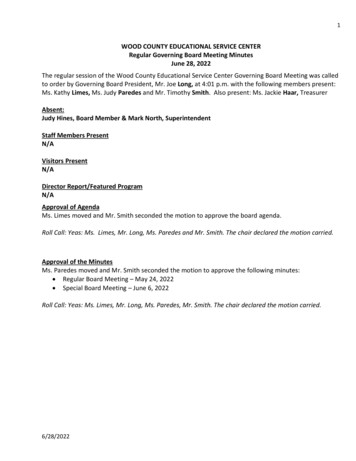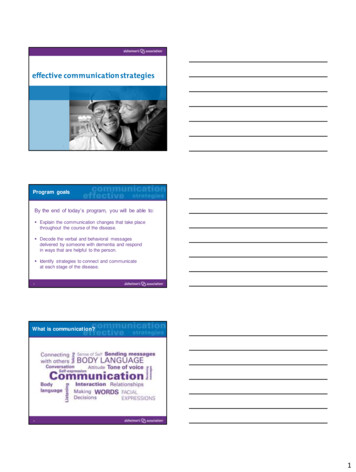
Transcription
V1.0 Effective: 02/2017 Review: 02/2022
Published by the State of Queensland (Metro North Hospital and Health Service), February 2017This document is licensed under a Creative Commons Attribution 3.0 Australia licence.To view a copy of this licence, visit creativecommons.org/licenses/by/3.0/au State of Queensland (Metro North Hospital and Health Service) 2016You are free to copy, communicate and adapt the work, as long as you attribute the State of Queensland(Metro North Hospital and Health Service).For more information, contact:Health Service Strategy and Planning, Metro North Hospital and Health Service, Herston, Qld, 4029,Email MNHHS PlanningStrategy@health.qld.gov.au, phone (07) 3647 9557.An electronic version of this document is available at www.health.qld.gov.au/metronorthDisclaimer:The content presented in this publication is distributed by the Queensland Government as an information source only. The State of Queensland makes no statements,representations or warranties about the accuracy, completeness or reliability of any information contained in this publication. The State of Queensland disclaims allresponsibility and all liability (including without limitation for liability in negligence) for all expenses, losses, damages and costs you might incur as a result of theinformation being inaccurate or incomplete in any way, and for any reason reliance was placed on such information.MNHHS Cancer Care Clinical Services Plan 2017-22Printed versions are uncontrolledPage 1 of 31
Contents1Executive summary. 32Introduction. 433.13.23.3Our patients . 5Our local MNHHS catchment . 5Our regional catchment . 6Our statewide catchment. 64The MNHHS cancer care service system . 75Issues and challenges . 96The next five years . 127Service Directions . 14Service Direction 1: Reduce our cancer risk and detect cancer earlier . 14Service Direction 2: Patients and their families will be at the centre of MNHHS cancer care services . 16Service Direction 3: MNHHS cancer care system is integrated, coordinated and efficient, providingbest practice care to our local, regional and statewide patients . 19Service Direction 4: Maximise utilisation of current capacity and grow capacity over time to delivertimely high quality care as close to home as clinically appropriate . 22Service Direction 5: MNHHS will be a world leader in advancing cancer care research in partnershipwith leading research and education bodies. . 258Implementation, monitoring and review . 279Methodology . 2810Policy context . 2811Consultation. 2813Assumptions . 29MNHHS Cancer Care Clinical Services Plan 2017-22Printed versions are uncontrolledPage 2 of 31
Part 11Executive summaryThe Metro North Hospital and Health Service (MNHHS) Cancer Care Clinical Services Plan (the Plan) has beendeveloped to support MNHHS to continue to be a leader in cancer care services for patients locally and acrossQueensland. The Plan will focus on strengthening the partnerships between services and service providers toenhance the patient journey within MNHHS and with other Hospital and Health Services (HHSs). Developed inconsultation with key stakeholders and informed by state directions contained in My Health, Queensland Future:Advancing Health 2026, MNHHS Strategic Plan, MNHHS Health Service Strategy and the Cancer care statewidehealth service strategy 2014, the Plan identifies five service directions to build a platform to achieve our goals toremain at the forefront of cancer care long term. These service directions include objectives, signs of successmeasures and actions that will guide service development to MNHHS cancer care services for the next five years.The service directions are:1. Reduce cancer risk and detect cancer earlier2. Patients and their families will be at the centre of MNHHS cancer care services3. MNHHS cancer care system is integrated, coordinated and efficient providing best practice care toour local, regional and statewide patients4. MNHHS will maximise utilisation of current capacity and grow capacity over time to deliver timelyhigh quality care as close to home as clinically appropriate5. MNHHS will be a leader in cancer research, innovation and education across all disciplinessupported by a highly skilled and integrated workforce with well-established partnerships withleading research and education bodies.The Plan has been developed based on the needs of patients and our commitment to improve care across thecancer care continuum from prevention, detection, treatment and survivorship through to palliative care.Once implemented, the expected outcomes of the Plan are: improved patient access to safe, contemporary high-quality cancer care services in the most appropriatesetting as close to home as clinically appropriate best practice patient-centred care from diagnosis, care planning and coordination to treatment, dischargeand follow-up practices irrespective of where people live productive partnerships across MNHHS services, between MNHHS and other HHSs, and with other serviceproviders who care for cancer patients, including pathology, medical imaging, oral health and primary careproviders commitment to continue to advance clinical and service research and clinical trials to improve the qualityand outcomes of cancer care more efficient and effective use of key resources, including enhanced education and developmentopportunities for our workforce.MNHHS Cancer Care Clinical Services Plan 2017-22Printed versions are uncontrolledPage 3 of 31
2IntroductionCancer is the leading cause of mortality in Queensland. By 2026, it is expected that there will be approximately42,000 cancer diagnoses for people living in Queensland including almost 8000 new cancer diagnoses for peopleliving in MNHHS. The combination of a growing and ageing population will mean that the rate of cancer incidencewill continue to grow with 50 per cent of Queenslanders likely to develop cancer in their lifetime. Whilst cancerincidence rates are increasing, earlier diagnosis and cutting-edge treatment options are resulting in higher survivalrates. This combined with advancements in early cancer screening and genomic medicine is changing the waycancer is detected and treated.MNHHS has a long and proud history of providing comprehensive specialist cancer care services to adults locallyand to the state of Queensland. The needs of patients and their families are at the centre of our health care withservices delivered across the State through a network of specialised and highly skilled health practitioners. Ourhighly skilled staff are national leaders in cancer research and clinical trials increasing our understanding of how toprevent cancer, develop new approaches to detect, diagnose and treat cancer and how to better support peopleaffected by cancer.MNHHS is the largest cancer care service in Queensland providing a comprehensive range of adult cancer careservices across a range of tumour streams with a particular focus on:MNHHS Cancer Care Clinical Services Plan 2017-22Printed versions are uncontrolledPage 4 of 31
Breast Lung Colorectal Melanoma Endocrine Upper gastrointestinal Gynaecologic Urological Head and neck Hepatobiliary Myeloma Lymphoproliferative disorders Leukaemia Myeloproliferative disorders Allogeneic transplantation Central nervous system. Autologous transplantationCancer is a complex disease that can present in many different ways and depending on the tumour type a cancerpatient may require a range of treatments in a number of settings. Similarly the patient journey across the carecontinuum is not always linear and can be unpredictable and complex. Our priority is to support the patientthroughout the entirety of their journey.3Our patientsMNHHS provides care to adult cancer patients from three catchments: the MNHHS population, a regional populationcatchment and all of Queensland. Some of our services also care for people from northern New South Wales andthe Northern Territory who require the most complex cancer care. Our local MNHHS residents make upapproximately 75 per cent of patients accessing our services. However for more specialised services, we care for asignificant proportion of residents from other regional and statewide areas. Across all catchment areas, we expectsignificant growth in the future placing a greater demand on the service system.3.1Our local MNHHS catchmentOur local MNHHS catchment area covers the Brisbane City Council area north of the Brisbane River, the MoretonBay Regional Council area and the statistical local areas Somerset (R) – Kilcoy. Children within our catchment whorequire cancer care services are cared for by Children’s Health Queensland.By 2026 the total MNHHS population is anticipated to grow by 17.7 per cent to over one millionpeople.This population growth will not be equally distributed. High population growth is expected in the northern part ofMNHHS around Caboolture and Redcliffe Hospitals. The Caboolture Hospital catchment adult population isexpected to experience the highest growth at a rate of 31.3 per cent and the Redcliffe Hospital catchment adultpopulation expected to grow by 22.9 per cent by 2026. Additionally the Caboolture and Redcliffe Hospitalcatchments are expected to experience the highest growth rates in residents aged 65 years and over, at 42.7 percent and 36.2 per cent respectively. With the highest levels of socioeconomic disadvantage in the HHS, these areashave greater potential for health inequality.In contrast, the Royal Brisbane and Women’s Hospital (RBWH) and The Prince Charles Hospital (TPCH) catchmentadult population have lower levels of socioeconomic disadvantage and will grow by approximately 14.7 per cent and9.9 per cent respectively in the same period.Over the next ten years the number of people diagnosed with cancer who live in MNHHS is anticipated to increaseby 31 per cent. This means the rate of cancer incidence is expected to rise almost twice as quickly as the populationover the next ten years.MNHHS Cancer Care Clinical Services Plan 2017-22Printed versions are uncontrolledPage 5 of 31
In 2013, 5058 MNHHS residents were diagnosed with cancer representing just over 19 per cent of total Queenslandcancer incidence. The MNHHS cancer incidence rate amounted to 540 cases per 100,000 population, slightly higherthan the Queensland rate of 533 cases per 100,000 population. Together, the Caboolture and Redcliffe Hospitalcatchments within MNHHS accounted for almost 40 per cent of total MNHHS cancer incidence in 2012 and 2013,whilst representing only 33 per cent of the MNHHS population.3.2Our regional catchmentMNHHS also delivers services to patients from other HHSs who require more complex care than can be safelyprovided locally. In particular, MNHHS supports patients from Sunshine Coast, Wide Bay, Central Queensland andCentral West HHSs in this way. This regional catchment represents another 673,644 adults. Similarly to MNHHS,these HHSs are ageing and are expected to grow 18.5 per cent to 815,479 adults by 2026.Over the next ten years the number of people diagnosed with cancer that live in the regional catchment is expectedto increase by approximately 34 per cent. In 2013, 5506 residents who live in the regional catchment werediagnosed with cancer. Within Queensland, cancer incidence is highest in Wide Bay HHS, with 560 cases per100,000 population diagnosed in 2013.3.3Our statewide catchmentAs the largest cancer care service in Queensland, MNHHS is the sole provider of a number of specialised cancercare services to all Queensland residents. Over the next ten years, the Queensland population is expected to growto 5,730,056 persons with the adult population increasing by 20 per cent to 4,633,353 persons. Regional areas areexpected to grow faster than metropolitan areas. People aged 65 years and over are expected to increase by 55.7per cent.In 2013, the Queensland incidence rate for cancer was 533 cases per 100,000 population. Over the next ten years,the number of new cancer cases among Queenslanders will increase by 34 per cent.MNHHS Cancer Care Clinical Services Plan 2017-22Printed versions are uncontrolledPage 6 of 31
4The MNHHS cancer care service systemCancer care in MNHHS is delivered to patients through a comprehensive service system provided in the community,ambulatory and inpatient service settings. The current MNHHS service system includes:Cancer prevention and screening servicesGeneral Practitioners (GPs) provide services to patients to reduce behaviours known to increase the risk of cancerincluding reducing UV sun exposure, alcohol consumption, smoking and maintaining a healthy weight. GPs alsodeliver screening services to identify cancer early. Screening services delivered by GPs include cervical, prostateand bowel screening.BreastScreen Queensland (BSQ) delivers breast screening and assessment services to women living in most partsof MNHHS. There are six locations including Brisbane City, Indooroopilly, Chermside, Keperra, Kippa-Ring andNorth Lakes (Note: BreastScreen Queensland Brisbane Northside service catchment differs from MNHHScatchment).Oral health services (public and private) play a critical role in the early identification of oral cancers and supportingtreatment which is likely to prevent the progression of intra-oral lesions and subclinical-cancers.Genetic Health Queensland provides diagnosis, counselling and management advice to individuals and their familieswho have, or are at risk of having, a genetic or inherited condition including patients with a personal or family historyof cancer that is suspected to have a heritable basis.Cancer care services across MNHHS by siteThe table below provides an overview of MNHHS ambulatory, outpatient and inpatient cancer care services by siteas at January 2017.Table 1: Summary of ambulatory, outpatient and inpatient cancer care services available in MNHHS as at January gyOutpatientconsultMedicaloncologyOutpatientNorth Lakes48 spacesOutpatientRedcliffeHospital510 ital3NilNilOutpatientconsultOutpatientTPCH58 spacesOutpatientOutpatientconsultInpatient andOutpatientRBWH628 spacesComprehensiveTreatmentand slandHaemophiliaCentreNilAllogeneicbone marrowtransplantOutpatientsHaematology, Medicaloncology, Radiationoncology, Pharmacy,supportive careMedical oncology,Radiation oncology,Pharmacy,Psychology,supportive careMedical oncology,Radiation tationLiaisonNilNilBreast andcolorectalInpatient nLiaisonMedical oncology,Haematology,Radiation oncology,supportive careComprehensiveincluding tele-healthLimitedbreast andcolorectalLung andcolon(level 5CSCF)All tumourtypesInpatient andOutpatientInpatientsandoutpatientsInpatient andOutpatientConsultationLiaisonNilNilNilNilNote: A comprehensive service provides the full range of inpatient, outpatient, and ambulatory cancer care and specialised interventions to manage common cancers as well as rare cancers. Theservice may provide outreach services, as well as other support, to other cancer care services and cancer units within the cancer care network.Supportive careSupportive care services are physical, social, psychological, spiritual and information services that may be requiredby patients, their families and carers, in addition to cancer treatment. Dietetics, occupational therapy, physiotherapy,psychology, social work, oral health and speech pathology services across MNHHS support patients and their carersto address common cancer related issues including pain, deconditioning, fatigue management, function at home,weight loss, swallowing, emotional distress and adjustment to illness to improve function and quality of life.Chaplaincy services are available to provide spiritual support.MNHHS Cancer Care Clinical Services Plan 2017-22Printed versions are uncontrolledPage 7 of 31
A range of supportive care services for inpatients and outpatients are provided at RBWH, TPCH and RedcliffeHospital, while Caboolture Hospital provides some physiotherapy, speech pathology, dietetics, psychology andsocial work services for inpatients.Clinical support servicesSupport services including medical imaging, nuclear medicine, pathology and pharmacy are an integral part of thecancer care pathway that also makes valuable contributions in the diagnosis, management and treatment of cancers.Support services commonly form part of the multidisciplinary teams (MDTs) which determine diagnostic andtreatment pathways for patients. Pathology collections are undertaken on-site by Pathology Queensland (PQ) at all MNHHS facilities.Specialist pathology teams at PQ support cancer care services at RBWH and TPCH including lung cancerservices. Medical imaging: All MNHHS facilities have X-ray, ultrasound and computed tomography (CT) servicesprovided on-site. Other medical imaging services such as magnetic resonance imaging (MRI) are availableonsite at RBWH, TPCH, Caboolture Hospital and through an offsite provider at Redcliffe Hospital. Positronemission tomography (PET) is only available publically at RBWH. The Herston Imaging Research Facility(HIRF) also offers PET-MRI and CT-MRI services. Cardiac investigations: Echocardiography is available of all MNHHS hospitals. Nuclear medicine: RBWH is home to the largest nuclear medicine department in Queensland. Thisdepartment provides a comprehensive range of diagnostic scans and therapeutic procedures for both adultsand children. TPCH also provide nuclear medicine services. Pharmacy: RBWH and TPCH host specialist cancer care satellite pharmacies supported by centralpharmacies that manage the procurement and manufacture of chemotherapy and supportive medications forcancer care patients. Both Redcliffe and Caboolture Hospitals operate through a central pharmacy locatedwithin the main hospital. Cancer care pharmacies also support other services such as palliative care andcystic fibrosis. Oral Health: Oral health services are provided at RBWH, Redcliffe and Caboolture Hospitals and atcommunity clinics across MNHHS. Services include dental care prior to and during treatment, oralrehabilitation and the provision of dental prostheses.The private sector including general practice also plays a significant role in the provision of diagnosis and treatmentof cancer and many patients will move between the private and public sector throughout the duration of their care.Outreach servicesMNHHS works closely with other HHSs in both our regional and statewide catchments to build local capability and, insome cases, to provide local care through outreach and telehealth services led by MNHHS clinicians. In an effort totreat patients as close to home as is safe and practical, RBWH provides the following outreach services: haematology and radiation oncology consultations to Central Queensland HHS haematology and bone marrow transplant consultations to Sunshine Coast HHS medical oncology and radiation oncology clinics to Central West HHS the Queensland Haemophilia Centre team also provides outreach to Cairns, Townsville, Nambour,Toowoomba and Gold Coast Hospitals supportive therapies via telehealth to Longreach oncology day therapy unit.Palliative care servicesCancer care services work closely with palliative care services to support patients to access timely tailored care inthe appropriate service setting. TPCH and Redcliffe Hospital have designated inpatient beds for palliative careMNHHS Cancer Care Clinical Services Plan 2017-22Printed versions are uncontrolledPage 8 of 31
patients. Consultation liaison services are provided at RBWH, TPCH, Caboolture and Redcliffe Hospitals. Homebased palliative care is provided across MNHHS in partnership with general practice and other providers.5Issues and challengesThe cancer care health service system is rapidly evolving and whilst MNHHS is at the forefront of delivering cancercare we face a number of challenges over the next five years. How we deliver our services in the future will beimpacted by:Growing and ageing of population (local, regional and statewide)Cancer is a disease of the aged with strong correlations between increased cancer risk and age, and managingcancer in older patients is complicated by the higher prevalence of comorbidities, physiological and cognitive decline,and reduced social function. The expected growth in the cohort aged 65 years and over between 2016 and 2026 inMNHHS is 49.3 per cent, with the regional catchment 42 per cent and Queensland 55.7 per cent. Population growthand ageing will continue to drive increases in service demand and the complexity of care into the future.Lifestyle choices and behaviours that contribute to disease burdenSome individual lifestyle choices and behaviours can substantially increase the risk of a person developing cancer.More than a third of all new cancers diagnosed in Australia in 2010 were due to lifestyle-related risk factors such astobacco use, physical inactivity, high body mass and alcohol consumption. Tobacco continues to be the leadingcause with 13 per cent of all new cancers linked to tobacco, followed by exposure to solar radiation, inadequate diet,and obesity. While some risk factors such as smoking rates and second hand exposure have decreased in recentyears, lifestyle-related factors will continue to have an impact on cancer prevalence in the community.Earlier detection of cancerThe delivery of population-based screening programs such as the BreastScreen Queensland Program, theQueensland Cervical Screening Program, and the National Bowel Cancer Screening Program and screening in theprimary care setting will increase the number of cancers detected earlier. Advancements in genetics and genomicswill also provide early identification of risk of disease and detection of cancers. Increasing screening will result in acorresponding increase in need for treatment and surgery.Increasing cancer survival rates.MNHHS Cancer Care Clinical Services Plan 2017-22Printed versions are uncontrolledPage 9 of 31
While population growth and ageing continues to increase overall cancer cases, improved survival rates also mean arise in the number of people living with cancer. Approximately 70 per cent of people diagnosed with cancer will nowsurvive for at least five years after diagnosis. These numbers are expected to continue to increase, resulting inincreased support for follow-up care, support to manage side-effects of cancer treatment, and transition to life postcancer care.Disadvantage in the northern region of MNHHSThe health status of MNHHS residents varies significantly across hospital catchment areas. The northern corridor ofMNHHS, primarily Caboolture and Redcliffe Hospital catchment areas, has higher levels of socio-economicdisadvantage, limited access to GPs and a tendency to have comorbidities requiring more complex care, all of whichare placing a higher demand on cancer care, allied health and support services.Service connectivity across care settingsAt present cancer care service delivery is focussed on hospital inpatient and outpatient settings with limited use ofambulatory, home and community settings. Partnerships with primary and community care service providers acrossthe HHS are also limited. This impacts the utilisation of shared care models and the efficiency of the health system’sresponse to increasing cancer incidence.Changing expectationsIncreasingly consumers expect to receive more timely and individualised care when required and generally want tobe more informed and involved in the management of their own care. Patients more than ever before have accessto information about themselves and their illness and now have higher expectations of their healthcare includingwhat is reasonable in terms of access, safety and outcomes. As such taking note of patients’ requirements andresponding to their expectations should now be a central focus in how we deliver our care.Service system integration and coordinationFor residents of MNHHS, access to services, and the models and workforce through which they are provided, isinconsistent. Most cancer care services are organised on a facility rather than a HHS-wide basis, making integrationdifficult and creating access and workload variations between facilities. The lack of integration between services atMNHHS facilities has led to poor coordination, poor visibility of patients once care is shared with another facility andincreased barriers to access for patients.Coordination of careVariable access to multidisciplinary team review at MNHHS hospitals leads to some inconsistency in quality andinhibits standardisation of care. RBWH delivers multidisciplinary team reviews for a range of cancers including headand neck, hepatobiliary, neuro-oncology, breast, colorectal, lung, lymphoma, upper gastrointestinal, medullarythyroid, neuroendocrine and urological cancers. TPCH delivers multidisciplinary team reviews in pulmonarymalignancy and general surgery, and Redcliffe Hospital provides multidisciplinary team reviews for breast and othercancers. Care coordinators are available at RBWH, TPCH, Redcliffe Hospital. There is limited availability atCaboolture Hospital. Similarly, patient experiences diverge because care coordinators are not in equal supply ateach facility providing cancer care services.Access to services closer to homeChemotherapy and radiotherapy treatment are not in equal supply across the HHS. Insufficient chemotherapyservices are available locally in the TPCH, Caboolture and Redcliffe Hospital catchment areas. As a result, patientsoften travel to the RBWH for treatment that could safely be delivered locally. The recent opening of the North Lakescancer care service and the move to provide cancer care services in the Moreton Bay Integrated Care Centre on theRedcliffe Hospital campus will increase our capacity to provide local care for those living in the northern part ofMNHHS. However, more action is needed. In MNHHS, the RBWH remains the only provider of public radiotherapytreatment, essential to treating almost half of all cancers, which results in many patients travelling long distances tothe RBWH for care.MNHHS Cancer Care Clinical Services Plan 2017-22Printed versions are uncontrolledPage 10 of 31
Consistency of safety and quality across MNHHS facilitiesCurrently some aspects of cancer care services are not routinely measured or reported, potentially obscuring anyvariations between services delivered at MNHHS facilities. The absence of a formal framework for determining theappropriate cancer care services provided at each MNHHS facility has also presented a risk of poorer healthoutcomes and fragmented care due to factors such as the association between patient volumes and outcomes andthe lack of consideration of access to diagnostic and/or rehabilitation services.Increasing cancer service capacity and capability in regional HHSsWide Bay and Central Queensland HHSs have over the last five years grown the capacity and capability of their localcancer care services. Sunshine Coast HHS will also increase capacity and capability of cancer care servicesavailable locally in 2017. This has meant many cancer patients who once may have accessed cancer care servicesin MNHHS are receiving most or all of their care closer to home. Referral to RBWH for highly acute and complexpatients continues. This changing service profile will result in MNHHS seeing fewer patients requiring lower-levelacute care and growth in the number of patients requiring higher acuity t
Advancing Health 2026, MNHHS Strategic Plan, MNHHS Health Service Strategy and the Cancer care statewide health service strategy 2014, the Plan identifies five service directions to build a platform to achieve our goals to remain at the forefront of cancer care long term. These service directions include objectives, signs of success











